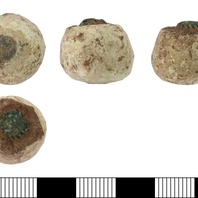
Viking Objects
Spherical Lead-Alloy Weight (DENO-650DB1)
This is a cast lead-alloy weight with a copper alloy Anglo-Saxon pin embedded in the centre. The base features a flattened copper alloy circular area that may be the worn remains of another embedded object. This piece demonstrates Anglo-Scandinavian reuse and repurposing of Anglo-Saxon metalwork. It has also been suggested that this item was a gaming piece although it does not resemble other known gaming pieces. Weights are an important form of evidence for Viking Age commerce and the use of standards across the different economic systems within which Vikings were integrated. Many of the weights discovered, particularly ones in Ireland and those of Arabic type, suggest that a standardized system of weights existed in some areas. These standard weights, alongside standard values of silver, are what allowed the bullion economy of Viking-occupied areas to function. A bullion economy was a barter economy that relied on the exchange of set amounts of precious metal in various forms, such as arm-rings or coins, for tradeable goods, such as food or textiles. Each merchant would have brought their own set of weights and scales to a transaction to make sure that the trade was conducted fairly.
Read More
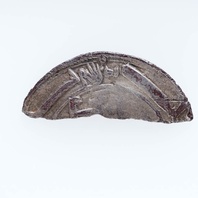
Item
Abbasid Silver Dirham Fragment (CM_1770_2008)
This fragment of a silver dirham was minted for the Abbasid ruler at Madinat al-Salam, [180-183] 796-799 CE . The dirham was a unit of weight used across North Africa, the Middle East, and Persia, with varying values which also referred to the type of coins used in the Middle East during the Viking Age. These coins were extremely prized possessions not only for their silver value but as a way of displaying one’s wealth and vast trade connections. Millions of Arabic Dirhams would have been imported throughout the Viking world and are mostly found in hoards. Arabic dirhams like this one from Torksey demonstrate contact between the Viking diaspora and the Arabic world. Arabic coins are especially useful for dating sites, because they carry the date when they were minted. This permits precise dating where the part of the coin with the date survives, whereas European coins can only be dated to the reign of the ruler depicted on them. In western descriptions of these coins, the Arabic dates found on the coins are usually listed in square brackets, as above, and the European equivalent is listed after it. This coin is a product of the Abbasid Caliphate which was ruled from its capital in Baghdad. The Abbasid Caliphate was at its greatest extent c.850 CE, occupying lands from Morocco in the west to Afghanistan in the east.
Read More
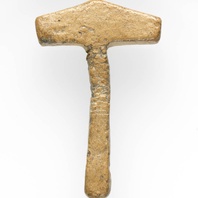
Viking Objects
Lead Thor’s Hammer Pendant (CM_569_2010)
A lead Thor’s hammer pendant with a trapezoidal head and pierced base. These may have been worn to show devotion to the god Thor, or to secure the god’s protection, although there is little evidence to support this interpretation. Pendants like this have been found made of lead, copper alloy, silver and gold, showing that many different strata of society could have worn them. For more information on Scandinavian jewellery in England check out our blog: Brooches, Pendants and Pins: Scandinavian Dress Accessories in England.
Read More
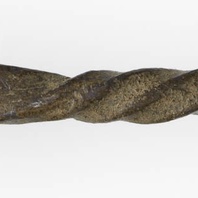
Viking Objects
Silver Ear Scoop Fragment (CM.1850-2008)
A fragment of a silver ear spoon or ear scoop with a body made from a spiral-twisted bar. Toilet articles like this were an important part of personal hygiene in the Viking Age. They were used to clean ear wax out of the ear and could be highly decorated to show off the user’s status.
Read More
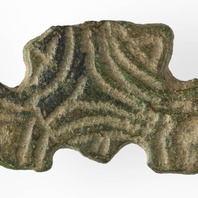
Viking Objects
Trefoil Brooch Fragment (CM.1823_2008)
A fragment of a Scandinavian copper-alloy trefoil brooch with a simple line pattern following its general outline. While of Scandinavian design, many examples found in the East Midlands were probably made in the Danelaw, and may have been copies of Scandinavian styles, instead of being imported from Scandinavia. For more information on Scandinavian jewellery in England check out our blog: Brooches, Pendants and Pins: Scandinavian Dress Accessories in England.
Read More
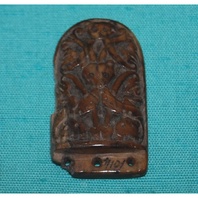
Viking Objects
Belt Terminal (L.A67.1864.3.0)
A belt terminal in an Anglo-Scandinavian zoomorphic style that was found in Leicester. It features two opposed ‘lions’, two central masks and acanthus scrolls. Strap ends or belt terminals came in various styles and were fairly common throughout the Viking world. They were used to decorate the ends of belts and to stop them getting damaged.
Read More
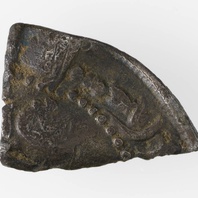
Viking Objects
Abbasid Silver Dirham Fragment (CM_1775_2008)
A silver dirham fragment possibly minted at al-`Abbasiyya. The dirham was a unit of weight used across North Africa, the Middle East, and Persia, with varying values which also referred to the type of coins used in the Middle East during the Viking Age. These coins were extremely prized possessions not only for their silver value but as a way of displaying one’s wealth and vast trade connections. Millions of Arabic dirhams would have been imported throughout the Viking world and are mostly found in hoards.
Read More
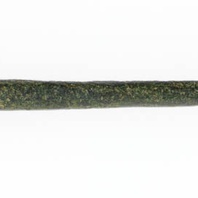
Viking Objects
Needle (CM. 1844-2008)
A cylindrical copper-alloy needle with a circular eye punched into a flattened section. Needles were a common textile tool and could be made from bone, metal or wood. They are generally considered to indicate the presence of female craftspeople, reinforcing the view that the Viking camp at Torksey was inhabited by women and children as well as the warriors of the Great Heathen Army.
Read More
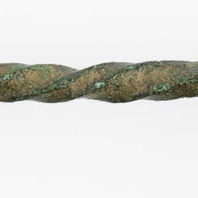
Viking Objects
Copper-Alloy Ear Spoon (CM_1849_2008)
This copper-alloy ear spoon has a spiral twisted body with a small rounded head. It was found at Torksey, Lincolnshire. Ear scoops (also known as ear spoons) were used to clean out ear wax. They are very common finds on Viking Age sites, suggesting that people took this aspect of personal hygiene very seriously.
Read More
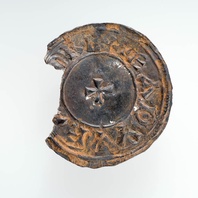
Viking Objects
Edward the Elder Penny (CM.615-1998)
A Horizontal type (HC1) silver penny of Edward the Elder (874-924), son of Alfred the Great, and minted by a moneyer called Beornwald. This coin was part of a hoard of twelve coins found at Thurcaston between 1992 and 2000. The coins are Anglo-Saxon, Arabic and Viking issues, and show the diverse and wide-ranging contacts between societies at this time. The hoard was probably deposited c.923-925, approximately five years after Leicester had been retaken by Mercia (c.918). They indicate that a bullion economy was still operating in the Danelaw as late as the 920s. This suggests that the reconquest did not immediately manage to institute Anglo-Saxon practices such as a monetary economy.
Read More
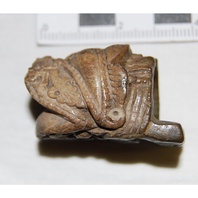
Viking Objects
Dragon’s Head Mount (L.A67.1864.1.0)
This mount from Leicester is in the form of a dragon’s head and is thought to be Scandinavian work. The base of the head is extended, slotted and necked as though for a hinge. There are green stains suggesting that it was attached to an item of copper or bronze. Mounts were generally used to decorate various items such as belts or pouches. In this case, it may have been a fitting for a knife. Mounts were usually attached to items by hammering over the metal studs on the back of the mount.
